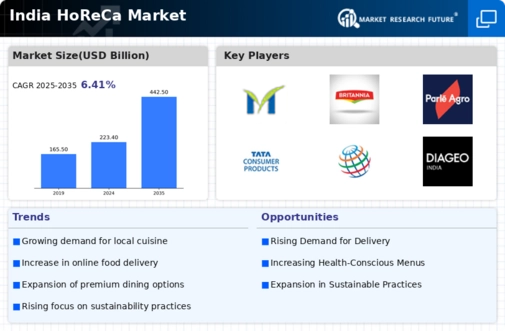Increasing Urbanization
The rapid urbanization in India is a pivotal driver for the horeca market. As more individuals migrate to urban areas, the demand for dining and accommodation services escalates. Urban centers are witnessing a surge in population density, which correlates with a higher demand for restaurants, cafes, and hotels. According to recent data, urban areas contribute approximately 60% of the total horeca market revenue. This trend is likely to continue, as urbanization is projected to reach 70% by 2030. Consequently, businesses in the horeca market must adapt to the evolving preferences of urban consumers, who often seek diverse culinary experiences and convenient dining options.
Culinary Tourism Expansion
Culinary tourism is emerging as a vital driver for the horeca market in India. Travelers increasingly seek authentic local dining experiences, which has led to a rise in food-focused travel. This trend is supported by the fact that food experiences account for nearly 30% of total tourism spending in India. As a result, restaurants and hotels are capitalizing on this opportunity by offering regional specialties and immersive culinary experiences. The horeca market is likely to benefit from this trend, as it encourages the development of unique dining concepts that attract both domestic and international tourists.
Growth of Disposable Income
The increase in disposable income among the Indian middle class is significantly influencing the horeca market. As economic conditions improve, more consumers are willing to spend on dining out and leisure activities. Reports indicate that the middle-class population is expected to grow by 10% annually, leading to a substantial rise in spending on horeca services. This trend suggests that the horeca market could see a revenue increase of around 15% over the next five years. The growing affluence is prompting businesses to innovate their offerings, catering to a more discerning clientele that seeks quality and unique dining experiences.
Focus on Sustainability Practices
Sustainability is becoming a crucial consideration for consumers in the horeca market. There is a growing awareness regarding environmental issues, prompting businesses to adopt sustainable practices. This includes sourcing local ingredients, reducing food waste, and implementing eco-friendly packaging. Recent surveys indicate that around 70% of consumers are more likely to choose establishments that prioritize sustainability. As a result, horeca businesses are increasingly aligning their operations with these values, which not only meets consumer demand but also enhances brand reputation. This focus on sustainability is likely to drive growth in the horeca market as environmentally conscious consumers seek out responsible dining options.
Technological Advancements in Service Delivery
Technological advancements are reshaping the service delivery landscape within the horeca market. The integration of digital platforms for reservations, online ordering, and contactless payments is becoming increasingly prevalent. Data suggests that approximately 40% of consumers prefer using technology to enhance their dining experience. This shift is prompting horeca businesses to invest in technology to streamline operations and improve customer engagement. As technology continues to evolve, the horeca market is expected to see enhanced efficiency and customer satisfaction, which could lead to increased loyalty and repeat business.

















Leave a Comment